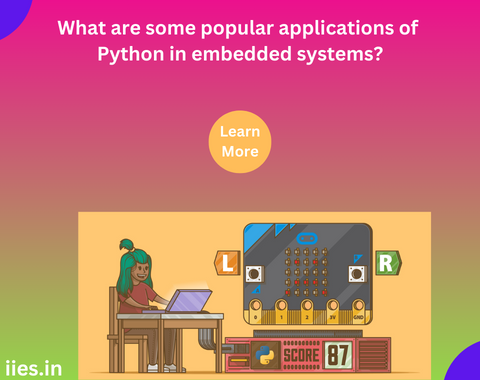
In the realm of embedded systems, where efficiency, reliability, and resource constraints reign supreme, Python might not be the first programming language that comes to mind. Traditionally, C and assembly language have been the go-to choices for embedded development due to their low-level control and minimal overhead. However, Python’s rise in popularity extends even to this domain, thanks to its versatility, ease of use, and a myriad of libraries and frameworks tailored for embedded applications. In this article, we delve into some of the popular applications of Python in embedded systems, showcasing how it’s reshaping the landscape of embedded development.
1. Rapid Prototyping and Development:
Python’s simplicity and ease of learning make it an excellent choice for rapid prototyping and development in embedded systems. Its high-level syntax allows developers to quickly iterate over ideas, experiment with different algorithms, and prototype functionalities without getting bogged down in intricate details. Tools like MicroPython and Circuit Python provide lightweight implementations of Python optimized for microcontrollers, enabling developers to write code directly on embedded hardware, thus reducing development time and accelerating the prototyping phase.
2. IoT (Internet of Things) Application:
With the proliferation of IoT devices, Python has emerged as a preferred language for building applications that interact with connected devices. Its extensive ecosystem of libraries, such as asyncio, MQTT, and Requests, simplifies tasks like sensor data acquisition, communication with cloud services, and device management. Python’s versatility allows developers to build end-to-end IoT solutions, from edge computing on embedded devices to cloud-based data processing and analytics, fostering seamless integration and interoperability across the IoT ecosystem.
3. Embedded Data Acquisition and Processing:
Python’s rich ecosystem of scientific computing libraries, including NumPy, SciPy, and Pandas, makes it well-suited for data acquisition and processing tasks in embedded systems. Whether it’s collecting sensor data, performing real-time signal processing, or implementing machine learning algorithms on resource-constrained devices, Python provides the tools and frameworks necessary to tackle a wide range of data-centric applications. Additionally, libraries like PySerial facilitate serial communication with peripherals, further expanding Python’s utility in embedded data acquisition systems.
4. Embedded GUI Development:
Graphical User Interfaces (GUIs) play a crucial role in many embedded applications, providing users with intuitive ways to interact with devices and visualize data. Python‘s Tkinter library, along with other frameworks like PyQt and Kivy, enables developers to create cross-platform GUIs for embedded systems effortlessly. These libraries offer a plethora of widgets, layout managers, and styling options, allowing developers to design responsive and aesthetically pleasing interfaces tailored to the specific requirements of their embedded applications.
5. Embedded Web Development:
Python’s web development frameworks, such as Flask and Django, are not limited to server-side applications but can also be leveraged for embedded web development. By running lightweight web servers directly on embedded devices, developers can create web-based interfaces for configuration, monitoring, and remote control of embedded systems. This approach facilitates seamless integration with existing web technologies and enables access to embedded devices from any device with a web browser, enhancing accessibility and flexibility in embedded applications.
6. Firmware Development and Testing:
Python’s scripting capabilities and testing frameworks make it an invaluable tool for firmware development and testing in embedded systems. Whether it’s writing automated test scripts, performing firmware validation, or implementing continuous integration pipelines, Python streamlines the development lifecycle and ensures the reliability and robustness of embedded firmware. Frameworks like pytest and unittest simplify the process of writing and executing tests, enabling developers to catch bugs early and iterate rapidly during the firmware development process.
7. Education and Learning Platforms:
Python’s user-friendly syntax and extensive documentation make it an ideal choice for educational purposes in the field of embedded systems. Platforms like Raspberry Pi and Arduino, which are widely used for teaching electronics and programming, offer native support for Python, allowing students and beginners to learn embedded development in a hands-on manner. Python’s versatility and gentle learning curve lower the barriers to entry into the world of embedded systems, empowering learners to explore and experiment with embedded hardware and software.
Embedded Machine Learning and AI:
With the increasing demand for intelligent embedded systems capable of processing and analyzing data locally, Python’s ecosystem has become instrumental in integrating machine learning and artificial intelligence into embedded devices. Libraries like TensorFlow Lite and PyTorch provide optimized implementations of machine learning models suitable for deployment on resource-constrained devices. Python‘s ease of use and extensive support for deep learning frameworks enable developers to leverage the power of machine learning algorithms for tasks such as image recognition, predictive maintenance, and anomaly detection directly on embedded hardware. This opens up new opportunities for building smart and autonomous embedded systems that can adapt and respond to changing environments in real-time.
Edge Computing and Real-time Processing:
Python‘s asynchronous programming capabilities, coupled with libraries like asyncio and Twisted, enable developers to implement edge computing solutions for real-time data processing and analysis in embedded systems. By offloading computational tasks from centralized servers to edge devices, Python facilitates low-latency processing and reduces dependence on network connectivity, making embedded systems more responsive and resilient. This approach is particularly advantageous in applications where timely decision-making is critical, such as industrial automation, autonomous vehicles, and smart infrastructure.
Security and Cryptography:
Python’s extensive support for cryptographic algorithms and security protocols makes it well-suited for implementing secure communication and data encryption in embedded systems.
Python‘s versatility and extensive ecosystem have propelled its adoption in embedded systems, opening up new possibilities and redefining the way embedded applications are developed and deployed. From rapid prototyping and IoT applications to data acquisition, GUI development, and firmware testing, Python’s presence in the embedded space continues to grow, driven by its simplicity, flexibility, and community support. As the demand for interconnected and intelligent embedded systems continues to rise, Python is poised to play an increasingly prominent role in shaping the future of embedded development.
Indian Institute of Embedded Systems – IIES